 |
 |
 |
A Nintendo community
by the fans!
|
 |
 |
∧ |
Forum main |
|
 |
Top Ten 3D Classics for 3DS Wishlist Part 1: NES [top ten]
|
|
|
 |
 |
|
 |
 |
|
 |
 |
 |
 |
When Nintendo announced the eShop for the 3DS, it announced a couple of things. First, it announced that it would include the DSi Ware Store. Second, that it would feature a new portable Virtual Console. But, more interestingly, that it would feature newly remade NES and SNES games that would take advantage of the features of the 3DS. Nintendo dubbed these games, 3D Classics. The first title, Excitebike, has already come out and demonstrates some of the upgrades that can be done to these old games. The following are the 3D Classics I’m most interested in seeing for the NES. In addition, I will also discuss how the title can take advantage of the features of the 3DS. As a default, I would like every title to feature Widescreen 3D, no HUD (Heads Up Display) on the top screen (unless specified), and a customizable control scheme. Also, most of the extra bells and whistles, such as level selects and extra functionality should be given to the player after they beat the games as a reward for their hard work.   |
 |
 |
 |
 |
 |
06/28/11, 06:29 Edited: 06/29/11, 00:35
|
|
|
|
|
 |
 |
 |
|
 |
 |
|
 |
 |
|
 |
 |
 |
 |
 |
Release Date: February 1998 Developer: Konami Publisher: Konami Contra is one of the most well known games for the NES. Even though it is not the first game to use the Konami code, it is the most famous. The reason for this is that the game is so hard, almost no one could complete it without the use of the code. The first game stars Bill and Lance, two commandos sent to South America to stop the invasion of the alien force known as the Red Falcon. The players traversed through sidescrolling, upwardscrolling, and even forwardscrolling screens, shooting everything in sight and earning power ups which would help them to defeat the enemy. At the end of each stage, they would face an alien boss which they would have to defeat in order to proceed. The second game is pretty much the same. It even has a similar storyline, in which Bill and Lance fight against humans possessed by the Red Falcon, in addition to mutated aliens. However, instead of the forwardscrolling mazes, the players now traversed overhead stages. I am most interested in playing the original game because it is my favorite of the two, and because it is harder. Upgrades: I would like a Save Feature after every level and a Level Select. The Konami Code better be included too. The touch screen can be used as a menu for weapons. Instead of losing the weapons you acquire, you can hoard them and use them when you need them, accessing them by touch. Every time you die, you lose the weapon you were using. I would also like multiplayer support via Wi-Fi and local multiplayer. I would also like Boss Rush Mode. And lastly, I would like unlockable versions of the arcade games.  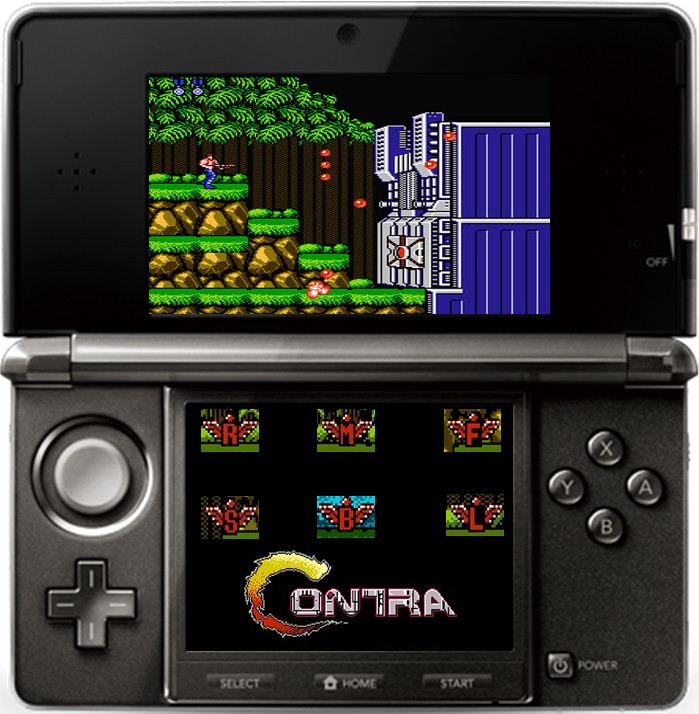
|
|
 |
 |
 |
 |
|
|
 |
 |
 |
|
 |
 |
|
 |
 |
 |
 |
 |
Released Date: October 1985 Developer: Nintendo Publisher: Nintendo Donkey Kong was developed in 1981 by Shigeru Miyamoto after being tasked with making an arcade game by Hiroshi Yamauchi (then president of Nintendo). The game was going to be a licensed Popeye game but that fell through. Miyamoto designed Jumpman, Lady, and Donkey Kong as mirrors to Popeye, Olive, and Bluto. The game was a huge success, Jumpman and Lady were renamed Mario and Pauline, and the rest…I think we all know how that turned out. In Donkey Kong, Mario must navigate through 3 levels (four in the arcade) of a construction site in order to save Pauline from Donkey Kong. He must evade barrels, springs, and even sentient fires. In Donkey Kong Jr., Mario is now the enemy. He has kidnapped Donkey Kong and his son Donkey Kong Jr. must save him. Jr. must evade snapjaws, buzzards, and even electric sparks in order to save his father. In Donkey Kong 3, a new protagonist, Stanley, must get Donkey Kong out of his green house before the bugs Donkey Kong has stirred destroy Stanley’s flowers. Now with regards to which game I would like to see the most as a 3DS Classic…read on. Upgrades: The Donkey Kong games are extremely short. You could probably finish the first two in less than 10 minutes. So, in this case, I would suggest that Nintendo releases the trilogy together to add value to the package. Oh, and bring back the lost level for the Original Donkey Kong. I would also like a Save Feature after every level and a Level Select. 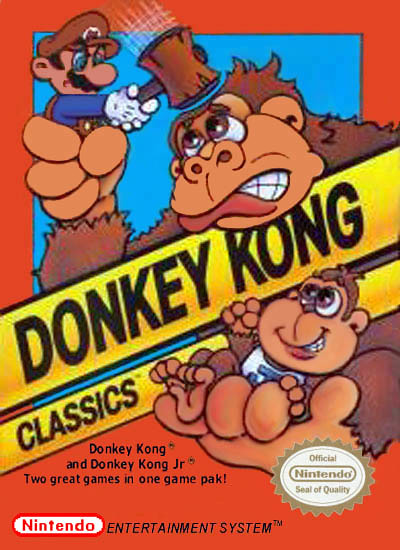 
|
|
 |
 |
 |
 |
|
|
 |
 |
 |
|
 |
 |
|
 |
 |
 |
 |
 |
Release Date: March 1989 Developer: Tecmo Publisher: Tecmo The Ninja Gaiden Trilogy for the NES was an important milestone for videogames. Ninja Gaiden demonstrated that videogames could be a medium for cinematic stories by introducing complex narrative and cutscenes. In addition, the gameplay was fast, tight, hard as nails, and fun as heck. In Ninja Gaiden, Ryu Hayabusa fights to avenge his father’s death and to rescue the Demon Statues from the evil Jaquio before he uses them to take over the world. Ryu travels to different lands slashing enemies with his sword and obtaining subweapons (such as shurikens and Ninja Arts) along the way. In Ninja Gaiden II: The Dark Sword of Chaos, Ryu fights his way through more enemies in order to save his girlfriend Irene Lew from the Emperor of Darkness, Ashtar. Along the way, he collects new Ninja Arts such as the clone ability, and meets up with old enemies, thought long gone. In Ninja Gaiden III: The Ancient Ship of Doom, Ryu is trying to find the people responsible for the murder of his girlfriend Irene. One of his new powerups is a Dragon Spirit Sword which extends the range of his sword. I am most interested in playing the second game in the series, which I think is the best one. Upgrades: I would like a Save Feature after every level and a Level Select. The touch screen can be used as a menu for weapons. Instead of losing the weapons you acquire, you can hoard them and use them when you need them. Every time you die, you lose the weapon you were using. I would also like a Boss Rush Mode. 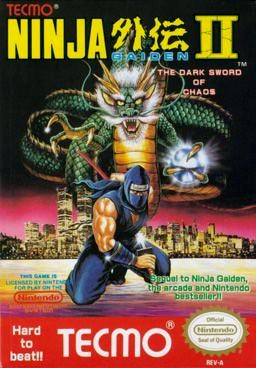 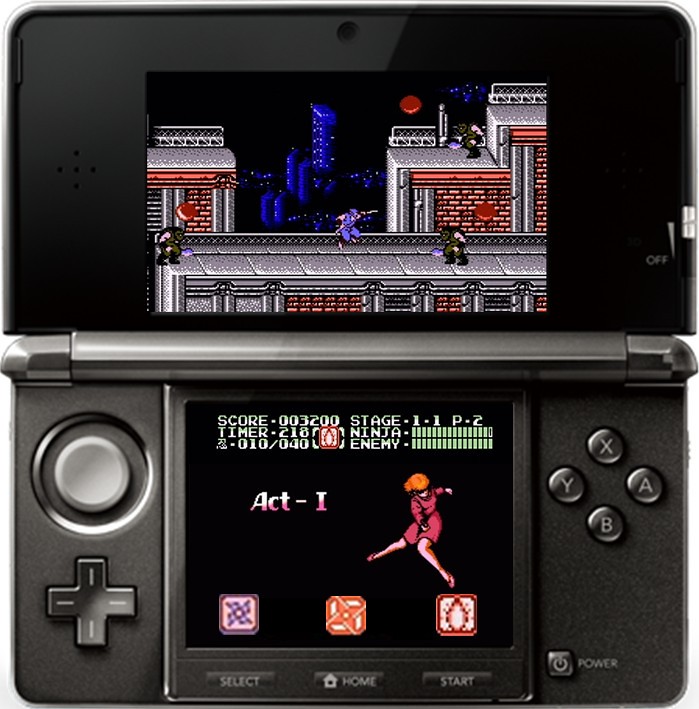
|
|
 |
 |
 |
 |
|
|
 |
 |
 |
|
 |
 |
|
 |
 |
 |
 |
 |
Release Date: September 26, 1986 Developer: Konami Pubisher: Konami Castlevania is one of my all-time favorite franchises because of its horror elements and great gameplay. The original trilogy is very different from the Casltevania games we get nowadays. These were side-scrolling action games were a fellow with a whip (and friends in the third game) fights against an army of monsters from many different mythologies. In Castlevania, you play as Simon Belmont, a member of the vampire hunter Belmont Clan. His mission was to travel through Dracula’s Castle, Castlevania, and defeat him using your whip and many subweapons. In Castlevania II: Simon’s Quest, Simon must rid himself of a curse Dracula placed upon him before he died. Simon must collect Dracula’s remains, resurrect him, and defeat him once more in order to rid himself of said curse. This game was different from the first game because it added an exploration element and towns to the series. It also added day and night cycles, where enemies were stronger during the night. The game also has RPG elements such as an inventory system and a leveling system. It is considered the black sheep of the franchise, much like Zelda II. In Castlevania III: Dracula’s Curse, Trevor Belmont, ancestor to Simon, must come to the aid of the people who had driven his clan away because of fear of their power. He is joined by three other characters, Sylpha Belnades (a priestess who can cast magic), Grant Danasty (a thief who can climb walls), and Alucard (Dracula’s son who can turn into a bat). Together they must defeat Dracula once more. I am most interested in the third game of the trilogy because it is, by far, the best. Upgrades: I would like a Save Feature after every level and a Level Select. The touch screen can display a map of where you are and can be used as a menu for weapons. Instead of losing the weapons you acquire, you can hoard them and use them when you need them. Every time you die, you lose the weapon you were using. I would also like a Boss Rush Mode. In Castlevania III, after beating the game and collecting all characters, allow us to use whomever we want by just touching their icon on the touchscreen, or cycling through them by using the L and R buttons. 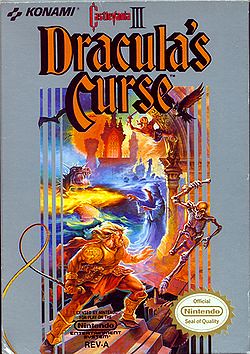 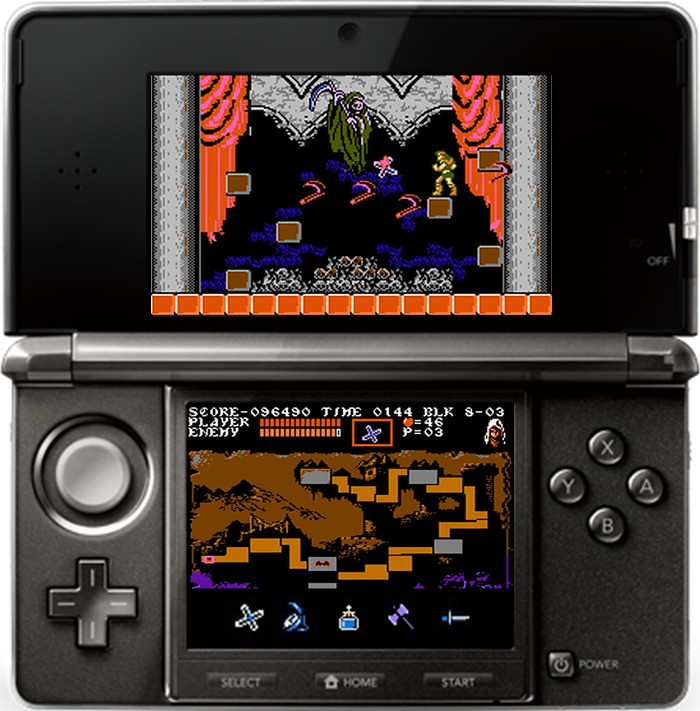
|
|
 |
 |
 |
 |
|
|
 |
 |
 |
|
 |
 |
|
 |
 |
|
 |
 |
 |
 |
 |
Release Date: December 17, 1987 Developer: Capcom Publisher: Capcom The Mega Man games are a staple of the NES era. The first Mega Man game was released in 1987 and introduced the world to the cute chibi robot Mega Man, his creator Dr. Light, and their archenemy Dr. Wily. All 6 games in the NES share similar stories and mechanics. You play as Mega Man and you must fight Dr. Wily and his evil robot creations (or reprogramations as in the first game). As you defeat each enemy, you gain their power, which you can use on other enemies who are weak to it. Megaman is basically a giant game of rock, paper, scissors trapped in a side-scrolling platformer. The one I’m most interested in seeing as a 3D Classic is Megaman 2, my personal favorite. Upgrades: I would like a Save Feature after every level. No Level Select is needed because the game already features one, unless you want to go to the Wily levels. The touch screen can be used as a menu for weapons, items, and energy tanks. A Boss Rush Mode in Megaman would be awesome, even though the games sort of already have one as part of Wily’s Castle. It would be cool to play as the bosses, like in Mega Man Powered up. It would also be cool to integrate maneuvers (such as sliding and charge shot) into earlier games. Allow us to program into some of the extra buttons. Finally, allow us to cycle through weapons by using L and R, just like in the Anniversary Collection. 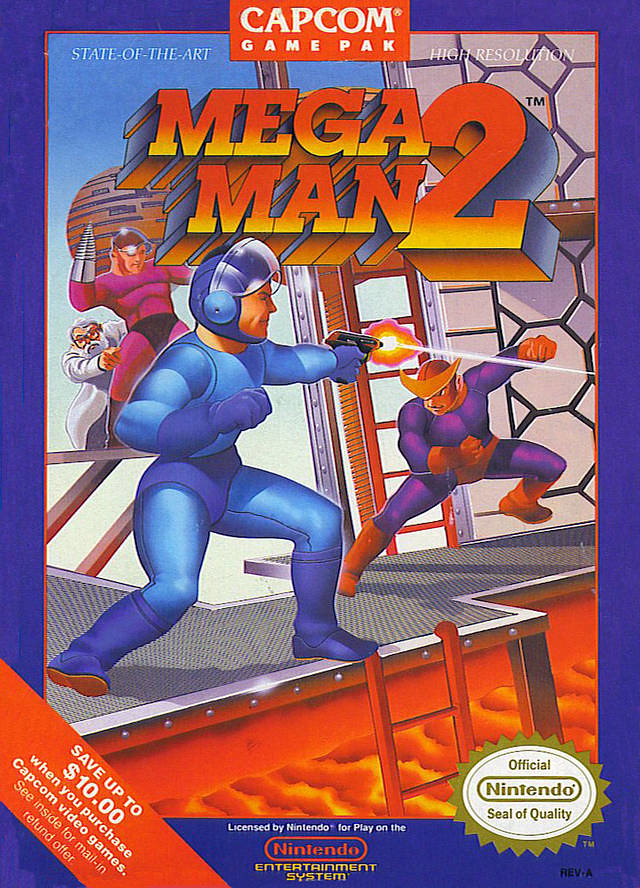 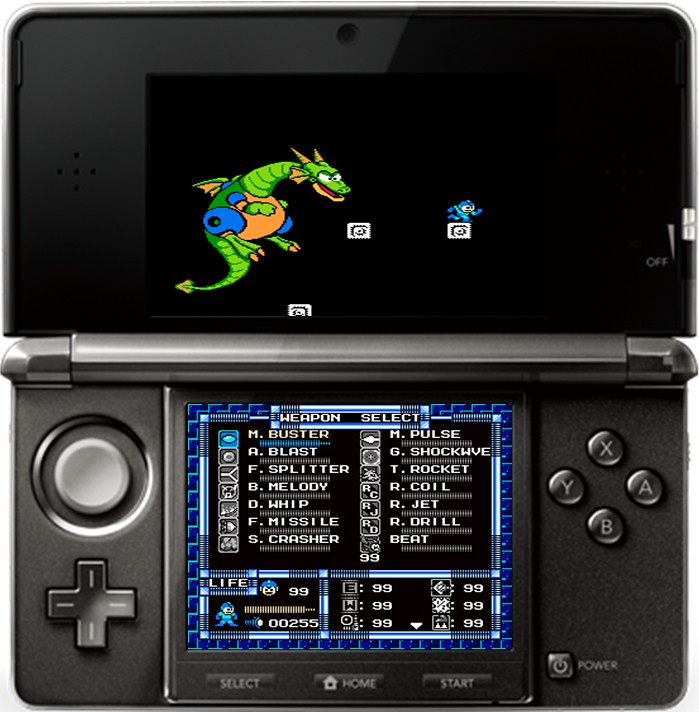
|
|
 |
 |
 |
 |
|
|
 |
 |
 |
|
 |
 |
|
 |
 |
 |
 |
 |
Release Date: October 1987 Developer: Nintendo R&D3 Publisher: Nintendo Mike Tyson's Punch Out!! is my favorite sports game of all-time, though calling it a sports game is a bit of a stretch. You play as Little Mac on your way to fighting all sorts of wacky opponents in order to fulfill your dream of becoming the boxing champion of the World. Your opponents have all sorts of awesome moves, such as teleporting and charging uppercuts. You on the other hand, can only punch, block, and evade like any other boxer. Occasionally, you can get a star from an opponent which allows you to use a stronger star uppercut. That, however, is the limit of your repertoire. Also, your opponents are twice your size and become far stronger and quicker as you progress. There has never been a portable version of Punch Out!! and I can think of no better way to remedy this than by making it a 3D Classic. Upgrades: In this game, I believe it is a better idea to leave the HUD on the top screen. The action is so fast that you need to have everything up there in case you need to give it a quick glance. I would like a Save Feature after every fight and a fight select after defeating every character. I would also like a Training Mode with Doc Louis, just like in Doc Louis’ Punch Out!!. The touch screen can display constant advice from Doc Louis and a real time status of your and your opponent’s face. This would mean that Nintendo needs to write a lot of new dialogue for this game. It would also be cool to have fighters from other Punch Out!! games. And last, but certainly not least, bring back Iron Mike Tyson as the last boss.  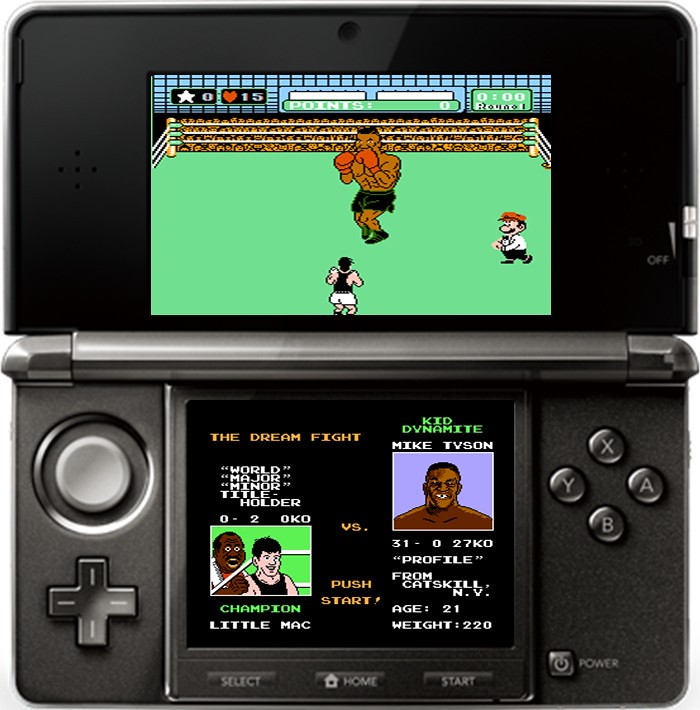
|
|
 |
 |
 |
 |
|
|
 |
 |
 |
|
 |
 |
|
 |
 |
 |
 |
 |
Release Date: August 6, 1986 Developer: Nintendo R&D1 Publisher: Nintendo I’ve been familiar with the Metroid series since the original came out in 1986. However, it wasn’t until Metroid Fusion that I really got into the series. I loved the exploration aspect and how I could access new areas, which had always been there, after acquiring new weapons. Plus, it was a more mature IP, something Nintendo needs more of. Even though I have played through, Metroid Zero Mission, I have never really finished the original game. I just find it a bit clunky by today’s standards. I feel that a 3D Classic version will fix this. Here’s how… Upgrades: Introduce save areas just like in other Metroid games. The touch screen can display a persistent map of where you are and can be used as a menu for weapons. Introduce hint rooms, (like the Sheikah Stones from Ocarina of Time 3D) which will help those who get lost. Instead of having your weapon substituted by a better one, I would like to have access to all the weapons at all times (once you acquire them). Finally, introduce a 3D 8-bit version of the Metroid Zero Epilogue after defeating Mother Brain. 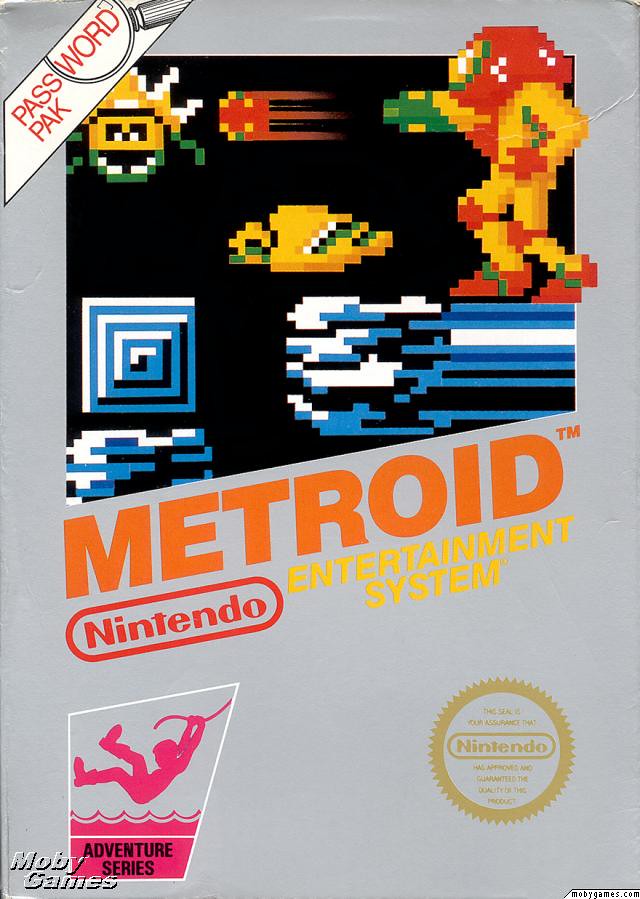 
|
|
 |
 |
 |
 |
|
|
 |
 |
 |
|
 |
 |
|
 |
 |
 |
 |
The Legend of Zelda Series |
 |
Release Date: August 22, 1987 Developer: Nintendo EAD Publisher: Nintendo The Legend of Zelda, my favorite videogame series, started its life in 1986 on the NES. The game was huge (for its time) and featured interesting gameplay elements like an overworld and dungeons, with lots of secrets hidden throughout. In The Legend of Zelda, Link must prevent Ganon from acquiring the Triforce of Wisdom (he had already stolen the Triforce of Power), which Princess Zelda has split into 8 pieces. Link must find these 8 pieces in order to defeat Ganon and rescue the princess. In Zelda II: The Adventure of Link, a Triforce crest appears on Link’s hand. He goes to Impa (Zelda’s protector) to find out what it is. Impa proceeds to tell him “The Legend of Zelda”:  She also tells him that the appearance of the crest means that he is the chosen one who must awaken the sleeping Zelda from the eternal slumber. The second game is a huge departure from the first. There is an overworld map, but all the action takes place in a side-scrolling 2D plane. Link is now able to use magic and he can also travel to towns and speak to NPCs. The game also introduces an experience system and lives. It is perhaps the strangest game in the Zelda series, and is considered a black sheep. I’m most interested in the first game, which is the best of the two. Upgrades for The Legend of Zelda: The touch screen can display the pause screen plus the HUD from the game. Also, it would be great if you could access your weapons by just touching the screen, just like in Ocarina of Time 3D. Maybe Nintendo can add a town just like Kakariko village, somewhere in the map where you can talk to people and they can tell you all about Hyrule. I would also like a Boss rush mode. Also, add mirrored and more difficult versions of both quests (but don’t eliminate the unmirrored versions like in Ocarina of Time 3D). Upgrades for Zelda II: The Adventure of Link: The touch screen can display the pause screen plus the HUD from the game. Also, it would be great if you could access your spells by just touching the screen. I would also like a Boss rush mode. Make the game more accessible by allowing us to restart a dungeon after we use up all our lives (with all the stuff we did already still done) instead of having to go back to Zelda’s Palace each time. Allow us to keep our experience when we use up all our lives, and give us continue points in each continent. Also, allow us to choose in which continent to start after continuing.  
|
|
 |
 |
 |
 |
|
|
 |
 |
 |
|
 |
 |
|
 |
 |
 |
 |
 |
Release Date: November 17, 1985 Developer: Nintendo EAD Publisher: Nintendo Super Mario Bros. is perhaps the most important game in the history of the industry. It resurrected the videogame industry, pretty much defined an era, and gave a blueprint to other companies on how to make games. In the first game, you play as Mario or Luigi (Player 2), traveling through the Mushroom Kingdom in order to save Princess Toadstool. Along the way, you can use super mushrooms to become bigger (aka Super Mario), fire flowers to become Fire Mario allowing you to shoot fireballs, and Starmen which make you invincible (unless you fall of a cliff). At the end of every world, you face off against Bowser, king of the koopas, and then you find out that the princess is in another castle. Super Mario Bros. 2 (The Lost Levels) is basically the same thing with added difficulty, poison mushrooms, and wind effects. Luigi can also jump higher in this game. In Super Mario Bros. 2 (USA) you play as either Mario, Luigi, Princess Toadstool, or Toad. You can pick up vegetables and throw them at enemies. The game is very different from the original (more on this in the trivia section). In Super Mario Bros. 3, Mario must save the rulers of the Mushroom Kingdom and eventually the princess. You gain new abilities from suits and you also gain the power to fly. Super Mario Bros. 3 is considered by many to be the best in the series and it is the one I most want to see as a 3D Classic. Upgrades for Super Mario Bros. and The Lost Levels: The Touch screen can display a map of where you are in addition to all the information you usually have on the top screen. Add extra elements from Super Mario Bros. Deluxe. These are: Boo races, Red Coin Challenge, Yoshi Egg Challenge, Toy Box, Multiplayer Versus Mode, level select (with the ability to keep your lives), extra animations, extra sounds, and Awards. In addition, as an homage to the Advance Series, I would like to see a full version of Mario Bros. in each of these games. One last thing, bring back the Negative World. Upgrades for Super Mario Bros. 2: Touch screen can display a map of where you are in addition to all the information you usually have on the top screen. Add elements from Super Mario Advance. These are: level select, point system with extra lives, Ace Coins, and Yoshi Challenge. And finally, add a fully playable version of Doki Doki Panic. Upgrades for Super Mario Bros. 3: Touch screen can display a map of where you are in addition to all the information you usually have on the top screen. You can also use the touchscreen to choose any item you have collected in the game, instead of having to use select them outside only. Add elements from Super Mario Advance 4. These are: choose to play as either Mario or Luigi with differing abilities, e-card levels, and Mario Bros. game. One last thing, eliminate that annoying blue bar at the left edge of the screen. Don't know what I'm talking about? Watch the video.  
|
|
 |
 |
 |
 |
|
|
 |
 |
 |
|
 |
 |
|
 |
06/28/11, 06:29 Edited: 06/29/11, 00:35 |
|
|
|
|
 |
 |
 |
|
 |
 |
|
 |
|
|
 |
 |
|
 |
 |
|
 |
 |
 |
 |
Trivia for NES
10 . Contra
Trivia for Contra:The home versions were localized in the PAL region as Gryzor on the various computer formats and as Probotector on the NES, released long later. The NES version of Contra differs from the arcade game in a few ways. All ten stages from the arcade version are present, although the "core" segments are no longer individual stages but boss battles that occur at the end of each base stage, reducing the total number of stages to eight. The base stages themselves were also made into linear levels instead of their original maze-like structure (resulting in the removal of the map display) and the time limit was removed as well. The rest of the game's stages are also expanded, featuring longer levels, more traps and enemies, and different bosses. The NES version of Contra was one of the earliest games to use the Konami Code, which originated with the NES version of Gradius. Inputting the code (entirely as the screen scrolls, or entirely after the screen is done scrolling) on the title screen before starting the game will grant each player thirty lives each time they start (both when a game begins and each time the game is continued).
Trivia for Super C: The gameplay and graphics of Super C are similar to the first NES game, but replaces the pseudo-3D stages with overhead stages much like its arcade counterpart. There are three stages unique to the NES version: a high-tech base, a mountain and an alien nest, all vertical-scrolling stages. The order of the latter stages and bosses are also slightly different, with new bosses featured in this version (including a new final boss). The NES version uses the same power-ups as the original NES game, but changes the function of the "fire gun" power-up from a gun that fires small fireballs that travels corkscrew pattern to a large projectile that spreads fire after hitting its target. The player can charge this gun by holding down the B button and then releasing it, shooting an even larger projectile that passes through most fodder enemies and causes an even bigger explosion when it hits a large target. The Rapid Bullets, Barrier and Special power-ups from the first NES game are also included in this game. The Konami Code from the original Contra was not included in this game. A different code was added which gives out thirty lives in the Famicom version and ten lives in the NES versions. Like in the Famicom version of Contra, the Japanese Super Contra has a stage select code that was removed from its NES counterparts. All three versions contain a sound test mode. Like the first NES game, Probotector II (the PAL version), replaced the main characters and some of the enemies with robots.
9. Donkey Kong
Trivia for Donkey Kong: Donkey Kong was created when Shigeru Miyamoto was assigned by Nintendo to convert Radar Scope, a poorly selling arcade game in the U.S., into a game that would have more appeal to Americans. The result was a major breakthrough for Nintendo and for the video game industry. Sales of the machine were brisk, with the game becoming the best-selling arcade machine of all time in its era. The gameplay itself was the first of its time. With the growing base of arcades to sell to, the game was able to gain huge distribution. A little well-known fact is that Donkey Kong was the first appearance of Nintendo's world famous Mario character - known as Jumpman in this game. The machine was Nintendo's first worldwide success.
Trivia for Donkey Kong Jr.: In an episode of Captain N: The Game Master, Simon Belmont got hit on the head and thought he was Donkey Kong Jr. In the Game Boy Advance version of Super Mario Bros. 3 the king of World 4 was transformed into a monkey with a 'J' on his shirt resembling Donkey Kong Jr.'s shirt. It was selected to be among five arcade games chosen for history's first official video game world championship, which was filmed at Twin Galaxies in Ottumwa, Iowa by ABC-TV's That's Incredible! over the weekend of January 8–9, 1983. The game later spawned a cereal which featured fruit-flavored cereal pieces shaped like bananas and cherries. Donkey Kong, Jr. is shown on the box wearing a red shirt with a big yellow J printed on the front.
Trivia for Donkey Kong 3: Donkey Kong 3 was not as successful as the previous two games, perhaps because its game structure is dramatically different. Stanley the bugman made an appearance in an episode of the Donkey Kong segment of Saturday Supercade titled "Greenhouse Gorilla", as well as a trophy in Super Smash Bros. Melee. Other than that, he has not made any other appearances in video games since. A Multi-Screen Game & Watch title, which is similar to Donkey Kong 3, is entitled Greenhouse. There is even a VS. Series Game & Watch version of the arcade game, but with different gameplay. In this version, player one controls Stanley the Bugman and computer player (or player two) controls Donkey Kong in a duel against each other using exterminating spray cans to move the bees to the other side of them to make the bees sting their opponents. Players can only hold up to three amounts of spraying liquid in their spray cans. On one player mode, the higher player one as Stanley scores, the faster the spraying liquid on the side of computer player as Donkey Kong drops.
8. Ninja Gaiden
Trivia for Ninja Gaiden: Although the NES game, Ninja Gaiden, was the second title to bear the name, there were few similarities to the arcade game. Ninja Gaiden in the arcade was a two-player co-op beat 'em up, reminiscent of other street fighting games such as Double Dragon. Besides the opening cinematic of a ninja duel and the similar opening urban stages, the NES and arcade games had different gameplay, graphics, and storylines. The game was made for the Nintendo Entertainment System (known as the Famicom in Japan) and was released in December 1988 in Japan under the title Ninja Ryukenden. It was developed and released the same time as the beat 'em up arcade version of the same name; neither of the two games were ports of each other but were parallel projects developed by different teams. Since the game's title was too difficult to read for English audiences, it was renamed when it was released in Western markets. In early 1988 advertisements from Nintendo Fun Club News, Tecmo used Dragon Ninja as a tentative title for the U.S. release. They decided to use the title Ninja Gaiden when the game was released in the U.S. in March 1989; the title literally meant "Ninja Side-Story", but the game was not intended as a spin-off of the arcade version. According to an interview with developer Masato Kato, the staff, determining how to translate "Ryukenden" into English, went with Ninja Gaiden "because it sounded cool". In Europe, the game was retitled as Shadow Warriors.
Trivia for Ninja Gaiden II: Dark Sword of Chaos: The game reuses several bosses from the first NES outing and there are normal enemies which resemble bosses from the first game. There has been much confusion and debate concerning who the true evil enemy is, between Ashtar and Jaquio.
Trivia for Ninja Gaiden III: The Ancient Ship of Doom: The Ancient Ship of Doom: The game difficulty was increased for the American release, by limiting the number of continues, increasing the damage done by enemies, and removing a password feature present in the Japanese version. Ninja Gaiden III actually takes place in between Ninja Gaiden and Ninja Gaiden II.
7. Castlevania Series
Trivia for Castlevania: The very first soundtrack in the series was composed by Kinuyo Yamashita, which is her only score provided for the series. Two different Japanese versions of Castlevania exist, which both differ slightly from their American and European counterparts. The original Akumajo Dracula released for the Famicon Disk System has a name-entry that allows the player to save his game. It also features an unique music track that can also be heard when entering a name in Castlevania: Harmony of Dissonance. The spots where candles are placed are also different and make it possible to collect powerful whip upgrades much earlier; making the game somewhat easier than other versions.
Trivia for Castlevania II: Simon’s Quest: This game was reviewed twice by James Rolfe's character, the The Angry Video Game Nerd. The phrase "What a horrible night to have a curse" used in this game to signify the coming of night time was used as the name of a Black Dahlia Murder song from the album Nocturnal. Similarly, the open portion of the music played in the forest during day time was used in the With Dead Hands Rising song "A Ghost for the Broken Hearted" on their album Behind Inquisition. The phrase "The morning sun has vanquished the horrible night" used to signify the coming of day time was referenced by Shanoa in Castlevania: Order of Ecclesiawhen she mentioned that she was the Sun that has come to vanquish this horrible night. One of the manors, Brahms, is somewhat of a typo but sounds similar to "Bram", as in Bram Stoker, the author of Dracula.
Trivia for Castlevania III: Dracula’s Curse: Castlevania III: Dracula's Curse is the first game in the series to lay an explicit connection with Dracula and the real life Vlad III the Impaler. There are four different endings to Dracula's Curse. Which one you receive depends on which additional character you beat the game with, if any. Each ending will start with the line "Trevor made many sacrifices. The long fight is over. Dracula is dead and all other spirits are asleep. When the game is completed without getting any of the other playable characters the game will show only Trevor watching the castle crumbling. It mentioned that he will someday get the respect that is owed to him, and the Belmont name shall be honored by all. With Grant as Trevor's partner it is said that they would become good friends, and Grant will start to rebuild the cities of Wallachia that were destroyed during the war. Trevor and Sypha's ending hits a more romantic tone. Sypha removes her hood and she reveals she is actually a woman. Trevor puts his arm around her. It is told that Sypha had a bad life, but since meeting Trevor, she started to feel more comfortable with herself. After completing the game along with Alucard, his feelings of guilt are elaborated on as they stand on the mountain cliff. Trevor realises this as he thinks about his friend.
6. Bionic Commando
Trivia for Bionic Commando: Known as "The Resurrection of Hitler: Top Secret" in Japan. For the release of the international version of the game, several changes were made. All references to Nazism in text and imagery were removed for the English localization. The Empire in the Japanese version was actually a neo-Nazi nation and the Imperial Army's insignia was a Nazi Swastika with a thunderbolt behind it. In the English version, the Nazis were referred as the "Badds" (though the back-story in the American version's manual referred to them as the "Nazz"), the Imperial Army's Swastika insignia was changed into a new one resembling an eagle, and the leader of the villains, originally called Weizmann in the Japanese version, was renamed Killt. One of the most prominent differences involves the ultimate antagonist of the game, who is meant to be a revived Adolf Hitler in the Japanese version (hence the title). For the English version, the character was renamed "Master-D", but his likeness to Hitler was unchanged. There is a notably gory ending sequence in which Hitler's face explodes, which was kept intact in the English version. In addition to the graphical changes, the difficulty of the game were rebalanced and some of the areas were made less difficult. In the Japanese arcade original, Super Joe was the hero, not Rad Spencer of the home consoles.
5. Mega Man Series
Trivia for Mega Man: This is the only Mega Man game with a score system. The American box art was completely different from the actual Mega Man concept. The reason for this was that the Capcom's American game developers thought that the cuteness of the character would not be attractive in the eyes of the U.S.A's public. That was also the reasoning behind changing "Rock" to "Mega" and "Rockman" to "Mega Man" - an attempt to make it sound more "western". However, the designer of the cover was asked to create it with little to no time before the game was released and had never viewed any of the source material or seen the game, thus creating a cover that almost has nothing to do with the game. It is also rated as one of the worst box art covers in video game history. Many people believe that Elec Man's stage music was inspired by the song "Faithfully" by Journey, from their classic 1983 album "Frontiers". Mega Man 1 was the only NES Mega Man game to not have any Robot Masters on the box art. They are on the Famicom cover, however. This is the only Mega Man game on the NES, which doesn't feature the Wily Castle map. This is the only Mega Man game to have hazards in the corridor before the Robot Master.
Trivia for Mega Man 2: This is Keiji Inafune's favorite Mega Man game. This is the first Mega Man game that shows the map of Wily Castle. This is the first Mega Man game to have Dr. Wily create his own set of Robot Masters, instead of using someone else's. This is the First Mega Man game to feature the standard eight robot masters instead of six from the first game. This is the first Mega Man game to have Energy Tanks, although the player could only carry four, instead of nine as in later installments.
This is the only game in the classic Mega Man series to have the same music for all boss battles. This is the only Mega Man game so far to have a Robot Master that is weak to his own weapon. This is the only Mega Man game where Mega Man can't receive any item in mid-air.
Trivia for Mega Man 3: Dr. Wily is misspelled "Dr. Wiley" in this game. This is the only Mega Man game in the series which most of the Robot Masters are built by Dr. Wily & Dr. Light together. This is the only Mega Man game which Dr. Light participated in the construction of the final boss (the only other case being X for Vile Mode in Mega Man Maverick Hunter X). This is the only Mega Man game to feature Question Blocks, which turn into a random item when shot. They were replaced with Eddie in Mega Man 4 and subsequent games. This is the first game in which Roll is actually named in-game. This is the first game in which Mega Man performs a final move (by running to the center of the room and jumping) where he obtains the defeated robot's weapon before leaving the room. Wily is apparently killed by falling debris at the end of the game. However, if the player pays attention during the ending sequence, his UFO is visible escaping far in the distance, hinting at his eventual return in Mega Man 4. At the end of the game, it shows the Robot Masters made by Dr. Right instead of Dr. Light (Dr. Right being his Japanese name). This is the only game in which the player will have to defeat at least one Robot Master (besides the first Robot Master selected) without that robot's weakness, as the "Rock, Paper, Scissors" weakness cycle is not a perfect circle since Needle Man is weak to the Gemini Laser gained from Gemini Man whose weak to the Search Snake obtained from Snake Man who is in return weak to the Needle Cannon. This is the only game in the original series that does not have a water/ice Robot Master and also one of the two games in the original series that does not have a heat/fire Robot Master (the other of which was Mega Man 5).
Trivia for Mega Man 4: The opening scene of the game shows Mega Man with blue hair, while the ending scene shows him with black hair. The Wily Machine in this game is the first of many to have the skull motif, a trend that is followed by all succeeding games' Wily Machines. This is also the first Mega Man game with the Wily Capsule as the final boss, which is used by Wily for the rest of the classic series. This is the first game to feature a unique music track for the game's last boss. This is the first time Mega Man can charge his buster due to the addition of the New Mega Buster. This is the first game where Dr. Wily tried disguising his intentions by making it seem as if someone else is behind everything. This is the only game in the series to feature two water-themed Robot Masters: Dive Man and Toad Man. Interestingly, when Dr. Wily appears after Mega Man destroys Dr. Cossack's machine, he teleports into the room, much like Mega Man and Proto Man, using Proto Man's teleporting sprite. It is possible for Mega Man to "kill" Dr. Wily after Wily escapes from his Wily Machine No. 4 in his escape pod by using the Rain Flush. However, doing this will result in Mega Man getting stuck in Wily's chamber and the player having to reset the game. The theme that plays during the credits is a remake of part of the Mega Man 2 opening. This is the first Mega Man game with two boss castles, Dr. Cossack's and Dr. Wily's. This is the first Mega Man game since the original where players can revisit Robot Master's levels. This is the first Mega Man game to feature "hidden" paths that can be taken to acquire special abilities.
Trivia for Mega Man 5: This is the first game to feature the Super Mega Buster. Mega Man 5 is the first game in the series to be dated 20XX, as opposed to 200X. This was the last NES Mega Man title to be released in the U.S. by Capcom themselves; its sequel, Mega Man 6, was released by Nintendo. This is the only game in the series where, during the boss rematch, Mega Man teleports to the room in which he fought the Robot Master in that particular Robot Master's level.
Trivia for Mega Man 6: After you defeat Mr. X in the NES version, there's a typo in his speech: "My scheme for world domination hasfaild!" This is one of the few Mega Man games not to feature Rush's trademark transformations (Jet, Marine, orCoil). Instead, he turns into equipment Mega Man can wear: one is a jet that allows Mega Man to have limited flying capabilities, and the other is a bulky armor that allows him to punch through walls. Both prohibit Mega Man's ability to slide. This is the first game where Mega Man is shown speaking. The robot masters in Mega Man 6 are often grouped by fans as the "element" (Plant Man, Blizzard Man, Wind Man and Flame Man) and "warrior" (Knight Man, Yamato Man, Tomahawk Man and Centaur Man) robot masters. If the Beat plates in the stages of Centaur Man, Knight Man, Tomahawk Man, and Yamato Man are obtained, the color palette of the stage changes.
4. Punch Out!!
Trivia for Punch Out!!: Genyo Takeda, who produced the Punch-Out!! arcade games, directed the NES versions. Because the NES was not as powerful as the arcade hardware, Takeda and his crew realized that it would be too difficult to make the NES port completely simulate the arcade versions. Instead of making the playable boxer wire-framed or transparent to see an opponent, they decided to shrink the playable boxer, so that players could easily see his opponents over his head. Though the arcade's playable boxer didn't have an official name, he was now known as "Little Mac", because of his small stature. Around the time the Gold Version was released, Nintendo of America's founder and former president Minoru Arakawa attended a boxing match featuring Mike Tyson. While watching the boxer fight, Arakawa became so astonished with the athlete's "power and skill", he was inspired to use the athlete's name and likeness in the upcoming port of the Punch-Out!! series to help the game sell well. Towards the end of the NES's run, Nintendo's license to use Mike Tyson as a special Punch-Out!! character expired. Therefore, Nintendo replaced Tyson with an original fictional character, Mr. Dream. A popular myth is that Tyson was removed due to his divorce from actress Robin Givens, and his conviction for rape, which did not occur until a year after the changeover. It is also believed by some that because Tyson lost the Heavyweight Championship to James "Buster" Douglas by the contract expiration, Nintendo made no attempt to negotiate a new one with him. In August 1990, the game was re-released simply as Punch-Out!! (or Punch-Out!! featuring Mr. Dream) only in North America. This version has become the "official" incarnation of the NES Punch-Out!!
3. Metroid
Trivia for Metroid: Based on the amount of time in which the player beats the game, there are five different possible endings. The possible endings are: 10 or more hours: Samus covers her face and turns her back to the player. Under 10 hours: Samus faces the player with one arm raised in the air. Under 5 hours: Samus removes her helmet, revealing that she is a woman. Under 3 hours: Samus removes her Power Suit, and is seen in a purple leotard. Under 1 hour: Samus removes her Power Suit, and is seen in a bikini.
Metroid, originally called "Space Hunter" during development, is notable for featuring a female protagonist, despite many games having a male protagonist at the time. Metroid was originally titled Space Hunter, before they changed it to Metroid, by combining the words android and metro subway.
2. The Legend of Zelda Series
Trivia for The Legend of Zelda: We don’t learn what “The Legend of Zelda” is until the second game. The Legend of Zelda was designed, directed, and written by Shigeru Miyamoto and Takashi Tezuka. The name of the princess was inspired by Zelda Fitzgerald. The nine dungeons that a player must traverse to complete the game each have the shape of an easily recognizable object (eagle, lion's head, snake, etc.), which make them easier for the astute gamer to navigate. The third labyrinth has the shape of what appears to Western audiences as a left-facing Swastika. This shape is actually a "Manji," which is a Buddhist symbol of good fortune. The last dungeon is over half the size of the entire overworld. If the entrance to the dungeon were placed directly on Spectacle Rock, the resulting world shape would be an L. In Japan this game is also known as "The Hyrule Fantasy". This is one of the only games where Link can only have a maximum of 16 hearts, the other 2 being Phantom Hourglass and Spirit Tracks. Most Legend of Zelda cartridges are gold, but there are very rare late releases of the game in standard grey cartridges.
Trivia for Zelda II: The Adventure of Link: We finally learn what is “The Legend of Zelda.” Many elements first introduced in this game have remained in the series. Starting with The Adventure of Link, all Zelda games have prominently featured a variety of NPCs who play pivotal roles in Link's quests. The use of metered magic and spells has also carried over into several Zelda games. The Triforce of Courage makes its first appearance in The Adventure of Link and plays an important role in later Zelda games, as it is strongly associated with Link. Dark Link also appears in Ocarina of Time, and a similar Link clone called Shadow Link appears in Four Swords Adventures. Many of the sages in Ocarina of Time bear the same names as towns from The Adventure of Link (Rauru, Ruto,Saria, Nabooru, and Darunia). Another town, Mido, is also the name of a character in Kokiri Forest. The Adventure of Link is the only Zelda game of the main English releases not to use "The Legend of Zelda" in its title, the only Zelda game to feature "lives" counting down, and therefore the only game in the series to include 1-up Dolls. This game marks the first time Link speaks in a canon game. He says "I found a mirror under the table" while in the town of Saria.
This is the only The Legend of Zelda game where hearts are absent, and replaced with red squares.
This is the only game where Link must place items at the end of the dungeons, rather than receive important quest items.
1. Super Mario Bros. Series
Trivia for Super Mario Bros.: After beating the game, the player is given the option to start the game again in Hard Mode, where all Goombas are replaced by Buzzy Beetles, and all enemies walk faster; all of the elevator-style lifts are about sixty-percent of their original size, while Firebars appear in all possible locations. Additionally, the music is slightly faster. According to the developers, some aspects in Super Mario Bros. was taken from The Legend of Zelda; firebars were one example, as they were present in the castles in The Legend of Zelda. Miyamoto implemented Firebars into Super Mario Bros. as an obstacle. The main goal of Super Mario Bros. was to have a character travel through many lands with all different themes to each other and it would feature a diverse terrain, such as land, water, and sky. They intended for the main character to be twice the size of the final one. In the beginning of developing the game, Mario wasn't supposed to be a playable character from the start. Instead, the players would have to control a 16 X 32 pixel square. The square couldn't even jump and as a result, Tezuka made Mario the playable character instead of the square. The Super Mario Bros. Deluxe manual and the the Virtual Console page of this game state that Koopas used black magic to aid their conquest of the Mushroom Kingdom, though the only other occurrences of this is by the Koopalings in Super Mario Bros. 3 and Bowser in Paper Mario (with the aid of the Star Rod) and in Mario Party. The Super Mario Bros. Stamps set was released in Japan at the end of May 2007. The stamps feature sprites of characters and items from this game. If the player manages to get 128 or more lives, he or she will receive an instant Game Over should he or she lose a life. The game somehow interprets this as the player having a negative amount of lives; this is likely due to data overflow. On the Wii Shop Channel, the loading screen for downloading any title is Mario or Luigi hitting Brick Blocks and collecting Coins, sometimes with a Fire Flower.Sometimes, both Bros. are shown swimming collecting coins.
Trivia for Super Mario Bros.: The Lost Levels: Nintendo of America believed that Super Mario Bros. 2, which was a slightly altered version of the first Super Mario Bros. game with an increased difficulty level, would not be a commercial success in the United States and elsewhere in the world. To deal with this, Nintendo commissioned a new Mario game to be made for the US/International market, which would be made by way of porting the popular Famicom Disk System game Yume Kojo: Doki Doki Panic and modifying it to feature Mario and his friends as playable characters. The game would furthermore be released in Japan during the wait for Super Mario Bros. 3 under the name "Super Mario USA". In Worlds 3-1 and 3-2, it is possible to jump over the Flagpole by jumping on a trampoline and hitting invisible blocks, respectively. In World 3-1, jumping over the flagpole will take the player to a backwards Warp Zone to World 1. In World 3-2, when the player is on the other side of the flag, they can finish the level by simply touching the flag, the same way as normal.
Trivia for Super Mario Bros. 2: Super Mario Bros. 2's genesis came about in 1987, when Nintendo of America got its first look at the Japanese version of Super Mario Bros. 2. Many characters and abilities from Super Mario Bros. 2 later reappeared in the Super Mario series. Shy Guys,Snifits, Bob-ombs, Pokeys, and Birdo were also introduced and would later be incorporated into later Mario games. Wart, the main villain, never reappeared in a video game, but has made an appearance in the Nintendo Comics System and has been mentioned in later games. He did, however, appear in Legend of Zelda: Link's Awakening under his Japanese name, "Mamu", as an ally. This is the first game to have Princess Toadstool and Toad as playable characters. Interestingly, the Super Mario Bros. 2 manual mistakenly used a few sprites from Doki Doki Panic, such as Phanto's original form, a magic lamp (which eventually became the Magic Potion), and a heart (which became the Mushroom power-up). The end credits contained some errors, such as Birdo mistakenly being labeled as "Ostro" (and vice versa), Hoopster was mistakenly labeled as "Hoopstar", Tryclyde's name was misspelled as "Triclyde", and Clawgrip's name was misspelled as "Clawglip". These errors remained unchanged in Super Mario All-Stars, but were fixed in Super Mario Advance.
Trvia for Super Mario Bros. 3: This marked the first appearance of the Koopalings and the Boo species.
The Nintendo Entertainment System version of the game was released twice in English. In the re-release, the names of the worlds were changed to (theme of world) Land, while the first English version used the original Japanese names. Other changes include a slightly different set of instructions from Toad's N-Spade game and a slight rewrite in one of Toadstool's letters, changing "Kuribo's Shoe" to "Goomba's Shoe". Defeating a boss while in the Frog, Hammer or Tanooki suit results in an alternate message from the newly transformed king. During 1988, a shortage of ROM chips, along with Nintendo of America's preparation of a version of Super Mario Bros. 2 for Western gamers (since the Japanese SMB2 was deemed too difficult), prevented Nintendo from releasing SMB3 and some other games (including, according to the magazine "Nintendo Power", "Zelda II: The Adventure of Link") in North America on schedule. |
 |
 |
 |
 |
|
|
|
|
|
|
 |
 |
 |
 |
First of all, I really like the mock-up images, makes it easy to see exactly what you're talking about.
I think widescreen should definitely be a standard, and yes, no HUD on the top screen would be very nice, except in the cases you pointed out (like Punch Out).
Some comments on your numbered list:
#10: As for Contra and Super C, yes, I also prefer the original.
At first I was thinking that the option of hoarding your different guns would break the gameplay. But actually, why not include that mode in addition to the classic mode (like an 'easy' vs. 'hard' mode). That way the purists are still happy.
#7: Castlevania III is probably my favorite of the Castlevania trilogy as well.
#6: I also liked the extra features in Bionic Commando Rearmed and would love to see that in the classic game.
#4: Whoa, you're asking for a lot in Mike Tyson's Punch Out, especially bring back Tyson himself, but then again this IS a 'wish' list!
#3: Nice, that's pretty neat that you're asking for a 8-bit rendering of the final part of Zero Mission, which itself was a remake of the classic game. Metroid would be really cool with the gameplay enhancements because I still love the charm of the classic 8-bit graphics and sound. That music is just so good.
#1: Yeah, that blue bar needs to go in SMB3. (I can't remember if it was there in the Wii VC.)
-----
If I made my own list, I would definitely want:
Kirby's Adventure! Other than Super Star, this game is still one of my favorite Kirby games, and it's where his trademark copy ability originated.
I would also like Crystalis, as well as both Star Tropics games.
(I still want to read some of the trivia and see how much I actually know about these games!)
Oh, and one thing you didn't mention (which was actually the first thing I thought of when you told me you were working on this list), is how the 3D itself would enhance the gameplay in any way. I would think the 3D would only serve to give the graphics some cool depth like it did in Excitebike (where the obstacles on the track actually have been completely re-done) but not really change the gameplay. What do you think?
-----
Oh, and the Excitebike 3D track editor could have been better if they used touch screen controls. It's kind of clunky having to scroll through the items and the track placement with the D-Pad. |
 |
 |
 |
 |
|
|
|
|
|
|
|
|
|
|
|
|
|
|
 |
 |
 |
 |
[ref=id=5978&pagenumber=1#159050]@Tranquilo[/ref] Yes, I know. Android and Metro are the last things I have on my mind when playing Metroid. I agree that maybe since they already did Zero Mission, they probably may not revisit Metroid. Then again, Nintendo is not shy with regards to rereleasing stuff 20 million times (look at Ocarina of Time). I do disagree with your Punch Out!! comment. That game has awesome mechanics and very few flaws. I agree with [ref=id=5978&pagenumber=1#159064]@Jargon[/ref]. The game is so good that they did an upgade 20 years later with basically the same mechanics. [ref=id=5978&pagenumber=1#159053]@roykoopa64[/ref] thanks for your comments. One thing I meant to include in the body (I'll include it now) is that most of the extra bells and whistles, such as level selects and extra functionality should be given to the player after they beat the games. The Mike Tyson license is a pipe dream but it would be so awesome if they were able to get it. Other pipe dreams include Zero Mission and the Challenge Missions for Bionic Commando, but they would make already legendary games even more awesome. I'll just checked on the VC and yes, Super Mario Bros. 3 still has that problem. I also checked the All-Stars Wii version and it doesn't have it. With regards to Excitebike, it was actually that game that inspired the Upgrades section of this Top Ten. It challenged me to think how I could make some of these old games even better. By the way, I'm glad you like the mockups. I worked really hard on them. [color=red] If you click on them, you can actually see the really large versions so you can appreciate them much better. For example:[/color] [pic=300x294]http://farm6.static.flickr.com/5068/5878959819_8033056244_b.jpg[/pic][ref=id=5978&pagenumber=1#159057]@anon_mastermind[/ref] and [ref=id=5978&pagenumber=1#159122]@chrisbg99[/ref] I actually can't wait to play games like the original Super Mario Bros. in 3D. I think that those simple pixel graphics against mostly monotone backgrounds would make the characters and other things pop much better than games like Excitebike and Xevious, were the background and the characters can blend together. [ref=id=5978&pagenumber=1#159080]@Guillaume[/ref] and [ref=id=5978&pagenumber=1#159085]@Het_Nkik[/ref] I didn't know this either. I was shocked when I found out. In fact, I didn't believe it at first and almost didn't put it in the trivia section but, after some thorough digging, I was able to verify it. Even though the american manual says otherwise (nothing new there) it is downright confirmed by the game designer Masato Kato (also worked on Chrono Trigger) in this [url=http://hg101.kontek.net/ninjagaiden/ninjagaiden9.htm]interview[/url]. Here's an excerpt: The Japanese Wikipedia says that the story of NR3 takes place in between the other two, since Ryu lost the Dragon Sword at the end of the second game. However, in the English manual, the events of both previous games are presented as lieing in the past. As I couldn't get hold of the Japanese manual, could you clarify this?
What? Does it really say that in the English manual? That's strange.
The events of 3 take place in between 1 and 2. NR2 had ended so well, so when we planned the follow-up, we had to ask ourselves, "how can we continue that?" So we decided to conclude the story around Foster set at a time before the second game.[ref=id=5978&pagenumber=1#159085] Het_Nkik said:[/ref][quote]I played (and beat) all three Ninja Gaidens in a row and I didn't know III takes place between the other 2. [ref=id=5978&pagenumber=1#159085]@Het_Nkik[/ref] I get all the trivia from many different places. Wikipedia, multiple game wikis, instruction manuals, etc. That's why there are half-thoughts in there. I leave everything as it was stated without any editorializing (not even for linking) so as to preserve the integrity of the trivia. At times, when there is something so controversial like the Ninja Gaiden 3 trivia, I will not put it in before I can verify it. [ref=id=5978&pagenumber=1#159121]@ploot[/ref] Start with your favorite game and work yourself down.  |
 |
 |
 |
 |
|
|
|
|
 |
 |
 |
 |
Het_Nkik said:I didn't not believe you about the Ninja Gaiden thing by the way. I do find that one incredibly interesting. I love that trilogy so much.
It's just stuff like this:
Wart, the main villain, never reappeared in a video game, but has made an appearance in the Nintendo Comics System and has been mentioned in later games. He did, however, appear in Legend of Zelda: Link's Awakening under his Japanese name, "Mamu", as an ally.
Where I'm just like, "Who wrote this!?" I agree. It struck me as contradictory when I read it myself. I thought about deleting the first sentence during proof reading, I thought that maybe he meant a "Mario game" instead of a "videogame." But since he corrected himself a sentence later I decided to leave it in there for the comic part of the trivia. I didn't mean to say that nobody believed me with regards to Ninja Gaiden III. I mean that I didn't believe it myself. After all, you, me, Guillaume, and thousands of others have spent decades believing that all NG games are chronological and suddenly we find out that they are not. I had to verify this thoroughly and I am more than happy to provide proof. It's like when I found out that Indiana Jones and the Temple of Doom was a prequel. My mind was blown! |
 |
 |
 |
 |
|
|
|
|
|
|
|
|
|
|
|
|
 |
 |
 |
∧ |
Forum main |
|
|




